(Previous instalment, “Best Foreign Films (For People Who Aren’t Into Foreign Films)“)
You know how the story goes. A group of friends decide that it’s time to try and get cultured and want to catch up on classic cinema. They stumble upon a list of top films like the American Film Institute Top 100 list. They look at the movie on top of the list. It’s Citizen Kane (it’s almost always Citizen Kane). They pop it into whatever device, sit down, and watch. The movie completely goes over their heads and they spend the next half-hour or so sittinh around and mumbling “that was good” while not really feeling like it was actually that good. Now how do I know that this, or something like it, happens? Because it was an exact plot point of an episode on The Sopranos.
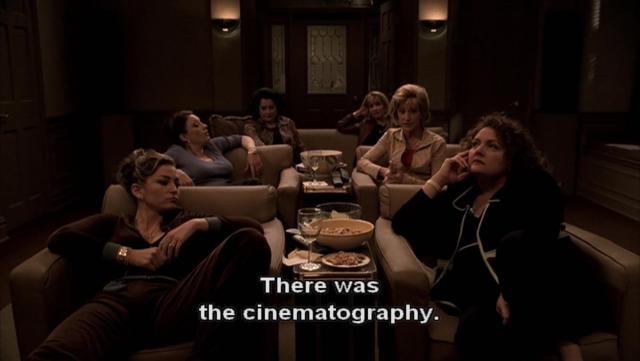
Now don’t get me wrong, the problem isn’t the people who didn’t get Citizen Kane. And the problem most certainly isn’t Citizen Kane. The problem is that the gulf between classic cinema and modern cinema is a wide one. Everything from editing techniques, to the aforementioned cinematography, to special effects, to acting techniques, all the way down even to how stories are structured has undergone some change in the intervening years. This is not a knock on either modern or classic cinema, as the changes in cinema have at least tracked with whatever similar changes in the rest of society has undergone. But it is this gulf that causes most of the consternation when the modern filmgoer pops in Citizen Kane. The genius of Citizen Kane is that it completely broke all the unspoken rules of classic cinema in ways that expanded cinema and anticipated modern cinema as we know it today. But in order to understand the movie’s genius, you kind of have to know what those unspoken rules are. So while Citizen Kane is without a doubt a brilliant (if slightly overrated) movie it is a horrible choice for the first classic movie you ever see.
So again, this is why I feel the need for this list. Much like foreign movies in my previous post, classic Hollywood cinema is another barrier (albeit a less daunting one) that keeps people from venturing out into uncharted cinematic waters. Much of that has to do with the fact that just like any teenager out there, the basic assumption is that if something is old whether it be music, fashion, TV shows, or as is the case here movies then it must be on some level lame (especially if it was a movie that your parents watched as kids). And while that is certainly true in some instances, I think we all know as we grow up that a wholesale rejection of our past is generally speaking an immature stance that we eventually grow out of (hopefully). And as evidenced by the hypothetical (or not so hypothetical) film group’s venture into cinema above, Classic Hollywood cinema is at least something that people have a desire to venture into. The challenge is trying to figure out where to start.
Unfortunately another barrier to entry with Classic Hollywood is simply the sheer enormity of possible movies to choose from. And more importantly the sheer enormity of mediocre and just plainly bad classic movies to choose from. The fact is that even though there are many, many movies that have been lost to us forever from this period, there are still many less-than-stellar so-called “classics” that remain in semi-regular circulation out there. Sometimes would-be classic movie enthusiasts make the mistake of thinking age is a guarantor of quality and end up picking a clunker which ruins their entire perception of all things “classic”. In addition when dealing with old movies, there is always the possibility that they may be more than a little retrograde especially when it comes to blatant depictions of sexism, racism, and a host of other such fun social issues. There is nothing like a blatant celebration of the Confedaracy (Gone With the Wind) or an unexpected appearance of blackface (hello, Swing Time!) to completely ruin or at least severely affect your ability to enjoy the movie.
So consider this list as a relatively safe “tour guide” into the world of classic cinema. Once again before we dive in, some basic rules:
- By “Classic” I mean any movie that was made before 1980. I chose 1980 as my cutoff date for two reasons. First, I was born in the 80s – so by extension I refused to be considered a “classic” yet (Just let me have this one). But more importantly that puts us right before the age of the blockbuster really arrived which did have a dramatic and permanent impact in terms of the kinds of films that got made from then on.
- I’ve also decided to exclude any and all Disney movies from this list just because even movies as old as Snow White (80 years old this year!) still remain relevant and widely watched. Whatever you think about Disney, they have done a fantastic job curating their films and keeping them ever present in our general consciousness so that they don’t fall into the “classic means boring” trap most of the other studios have with their portfolios. So my exclusion of Disney classic films isn’t a knock on Disney. I just don’t think I have to convince any of you that you need to watch them either.
- For the same reason, the all-time Christmas classics (It’s a Wonderful Life and the like) are similarly excluded. If there is some stated tradition somewhere that goes “every Christmas the whole family gathers round the TV and watches movie X” then I’m just bumping them off the list not because they are bad movies but just because those movies don’t need me to promote them either.
- I’m not putting silent films in this list because that is a whole different kettle of fish to handle. Let’s convince people that classic≠ “bad and boring” first before we open that pandora’s box.
And that’s more than good enough for me to start. So here we go:
10. DRACULA (1930) by Tod Browning & FRANKENSTEIN (1931) by James Whale
In what I hope won’t be a trend for me (but let’s be honest, it probably will) I squeeze two movies into one slot with the flimsy excuse that the two are connected just so I can avoid the hard decision of having to choose only one. But I just couldn’t think of a better way to start of this list than with the quintessential cinema monsters of Dracula and Frankenstein’s monster. And I do have many reasons for saying this.
First, it is astonishing just how much these two movies have shaped not only the template for horror movies in general, but how they have shaped our own understanding of these monsters. Hand a seven-year old a piece of paper and ask them to draw Frankenstein’s monster and he or she will unknowingly draw Boris Karloff. Ask that same seven-year old to do a Dracula impersonation and again, he or she will probably do a Bela Lugosi impersonation without realizing it. That is the textbook definition of being iconic.
But besides witnessing the very genesis of the horror genre, these two are also just really fun movies to watch. Modern sensibilities have made it so that there are episodes of Thomas the Tank Engine that are probably scarier than both of these flicks. And chances are you’re going to find yourself laughing more than you are to scream (in fact, I guarantee that will be the case). But really, that is all part of the charm of these movies. I argue they make the absolute perfect family double feature for Halloween (especially since both of them are less than 90 minutes), and I can’t wait until my kid is a little older to see these.
Alternative picks: Any other movie from the Universal Classic Monsters stable. Or for slightly scarier fare, The Innocents (1961) by Jack Clayton and The Haunting (1963) by Robert Wise are fantastic haunted house pictures.
9. HIS GIRL FRIDAY (1940) by Howard Hawks
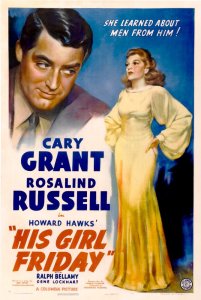
You have the impossibly quick rat-a-tat dialogue. You have a classic love triangle. You have corrupt politicians, opportunistic newspapers, a condemned criminal, and a wedding. In Cary Grant and Rosalind Russell you have one of the greatest onscreen pairings ever (though this is tragically their only joint appearance). It is a cacophony of one-liners so quick that you barely have enough time to hear just how good each of them are. Like any great screwball comedy it has so many moving parts and shifting allegiances that it will make your head spin. It is cynical movie, romantic in only the most utilitarian sense, and one of the smartest comedies ever written. As David Nugent of the New York Times wrote when this was first released, “Before it’s over you don’t know whether you have been laughing or having your ears boxed.” It is equal parts exhilarating and exhausting. And it is just simply one of the most fun pieces of cinema I have watched.
As an added bonus, since the first time that I saw this movie in a grainy and scratchy print, they have released a Criterion edition so that the print in now cleaned up and more importantly the audio is clearer than ever. So you now actually have a half-decent shot of catching at least a quarter of the brilliant verbal gymnastics this film goes through.
Alternative Picks: Some Like It Hot (1959) by Billy Wilder, The Lady Eve (1941) by Preston Sturgess.
8. AN AFFAIR TO REMEMBER (1957) by Leo McCarey

When I think of the best of classic Hollywood two things come to mind: lush production and star power. There is no genre in which lush production comes out more than romance movies and in Cary Grant (making his second appearance on the list!) and Deborah Kerr you get a glimpse of the kind of star power old Hollywood had, the kind that would pull people in based on just the name alone. Under the direction of Leo McCarey you have what I think is the perfect example of the classic melodramatic Hollywood romance.
The story of two would-be lovers who stumble upon each other in a chance encounter is as straightforward a premise for a romance as possible. But it is the way that McCarey dresses this simple story up that is particularly alluring whether it is the exotic locations (the Mediterranean coastline on a cruise liner), the fantastic costumes, or the swelling musical score. It is stereotypically glitzy, glamorous, and slightly over-the-top. And it is all kinds of wonderful.
Alternative pick: I would’ve picked Casablanca (1942) but I figured it was safe to assume that everyone has heard of Casablanca. But on the off-chance you haven’t go see that!
7. TOUCH OF EVIL (1958) by Orson Welles
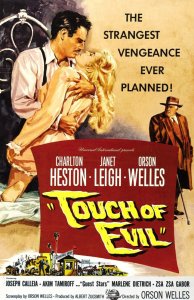
At first glance, Touch of Evil might get in to this list just because it fits so many categories at once. It’s a film noir, starring Charlton Heston and Orson Welles, and directed by the great Welles himself doing double duty. On pedigree alone it might earn its place.
It is also tempting to say this film that this movie gets in this list based on its iconic opening scene – an unbroken 4 minute shot that introduces the planting of a bomb in a car that kicks off the movie’s plot, runs above and through a bustling Mexican border town, follows the doomed car through those busy streets all the way to the border, still has time to introduce us to two of its main characters, and literally ends with a bang. It is truly one of the great opening shots of cinema if not one of the greatest scenes period.
But that would still sell this hardboiled crime movie short. For this is a fantastically told story about corruption on the border as Mexican and US investigators step on each others toes and cover up for each of their mistakes as they try and get to the bottom of who planted the bomb. In Mr. Welles’ Captain Hank Quinlan we have an all-time hall-of-fame villain as he takes centre stage in a film that, though close to 60 years old, still remains shockingly relevant today.
Alternative picks: Double Indemnity (1944) by Billy Wilder and The Night of the Hunter (1955) by Charles Laughton.
6. ALL ABOUT EVE (1950) by Joseph L. Mankiewicz
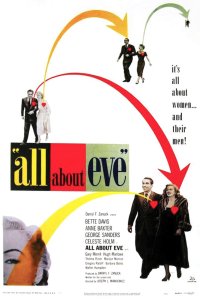
The Kardashians, every Housewives franchise, and just about every reality-TV competition can’t hold a candle to this deliciously shady story about the cutthroat backstage theatre scene. Starring Bette Davis, whose side-eye will never be rivalled, the story is about an aging Broadway star who takes in a seemingly innocent and enthusiastic fan (Anne Baxter) as her personal assistant. Predictably, it turns out this overly enthusiastic fan has ambitions of her own to use and usurp Davis to climb to the top. Since we know Davis is no chump, the ways and means both find ways to put down or one-up the other proves to be the chief delight of this movie. Add to this dynamic firecracker of an affair an equally manipulative and devious supporting cast led by the catty George Sanders as a theatre critic and you have all the makings of an entertaining glimpse into the ruthless ambition of the entertainment industry.
And if that wasn’t good enough you can toss into the mix the irony that all these actors and actresses were most definitely upstaged by a very early cameo of Marilyn Monroe, who would make a career of ruthlessly climbing to the top. As I mentioned right at the start, if the Housewives and the like are among your guilty pleasures then All About Eve will be right up your alley.
Alternative picks: Sunset Boulevard (1950) and Ace in the Hole (1951) by Billy Wilder
5. JAWS (1975) by Steven Spielberg
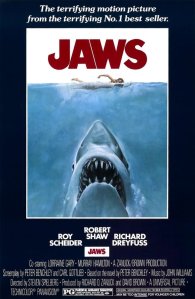 Now some of those among you might be tempted to dispute this film’s inclusion in the “Classic Film” list (you would be wrong or course). After all, it was made in 1975 which is by far the latest entry in the list. It was directed by Steven Spielberg who is still churning out movies to this day. And most importantly it’s widely considered to be the first “blockbuster” which is as far away a term as anything you could use to describe classic Hollywood. But this is precisely why I feel this movie is the perfect gateway to classic Hollywood. Jaws stands on the precipice of a major change in the way Hollywood did its business, and as such is the perfect blend of modern movie sensibilities and the classic style that preceded it.
Now some of those among you might be tempted to dispute this film’s inclusion in the “Classic Film” list (you would be wrong or course). After all, it was made in 1975 which is by far the latest entry in the list. It was directed by Steven Spielberg who is still churning out movies to this day. And most importantly it’s widely considered to be the first “blockbuster” which is as far away a term as anything you could use to describe classic Hollywood. But this is precisely why I feel this movie is the perfect gateway to classic Hollywood. Jaws stands on the precipice of a major change in the way Hollywood did its business, and as such is the perfect blend of modern movie sensibilities and the classic style that preceded it.
This is also a film I feel has had its reputation diminished slightly thanks to the slew of schlocky copycat movies that followed its wake and the horrible (and non-Spielberg) cash-in sequels that were made. To some it is easy to see this as merely a shock horror movie.
But that would completely miss just what a great movie this is. It is expertly paced, greatly edited, and a masterful showcase of tension and thrills. The score by John Williams is an all-time great (even when removing the oft-imitated main theme). For a supposed blockbuster, it is surprising just how patient the film is in building up the drama. And perhaps the greatest compliment I can give this movie is that no matter how many times I’ve seen this movie, that shark is still able to make me jump and make me just the teensiest bit wary of going back into the water.
Alternative pick: Superman (1978) by Richard Donner
4. SHADOW OF A DOUBT (1943) by Alfred Hitchcock
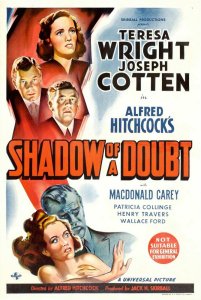
And here he is. Alfred Hitchcock. The master. I struggled the most in figuring out exactly which Hitchcock movie to go with for this list (because there was NO way Hitchcock wasn’t going to make this list). On the one hand there is his most (in)famous entry Psycho, but I felt picking that would simply reinforce the very wrong stereotype that the man is a “horror” director. Then there is Vertigo which comes with an extremely high critical pedigree (Sight and Sound’s No. 1!) but is not the easiest movie to digest. Rear Window, North by Northwest, The Birds, Rebecca, The 39 Steps, Rope, Notorious, and Strangers on a Train also got strong look-ins. But ultimately I decided that the film that should occupy the “Alfred Hitchcock” slot in this list should be the one that was actually his personal favorite, Shadow of a Doubt.
But I also chose this movie because it has so many of the elements present that helped earn Hitchcock the reputation of the greatest director ever. The story is about a young teenage girl Charlie Newton whose sedentary small town life gets turned around when her charismatic but mysterious namesake uncle turns up for a visit. And in classic Hitchcockian style, things turn out to be not quite as they seem as the movie slowly ratchets up the tension to an excruciatingly level leading to a climactic finale. It truly is the perfect introduction to the master of thrills.
Alternative picks: Take a look at all the other Hitchcock films above that didn’t make the list and just pick one. You really can’t go too wrong.
3. SINGIN’ IN THE RAIN (1952) by Stanley Donen and Gene Kelly
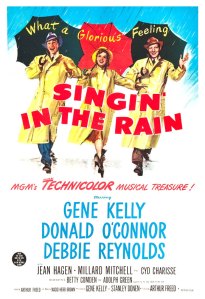
Much like Jaws above, this should be a movie that everyone has at least heard of. You’ve probably whistled, hummed, or full out sung the title song at some point in your life, preferably during some rainstorm. And on that basis alone I thought of maybe leaving it off my list. But then I realized that though the central images of this film are iconic, this still is a movie where astoundingly the whole is greater than the sum of its parts.
The best movies are the kinds that fly by without you noticing how long it takes, and if that is the case then Singin’ in the Rain zooms at lightning speed. The movie just has so much energy and verve that you can’t help but get caught up in it’s giddy excitement. Peripherally the movie tells the story about the rise of a Hollywood star and the making of another but that is besides the point. No one is here for the plot . We’re here to see Gene Kelly, Donald O’Connor, and Debbie Reynolds sing, tap dance, and saunter their way into our hearts. It is such a showcase of these artists’ talents that many a time in the middle of their song-and-dance numbers I found myself in wondering how in the world we got to where we were in the movie and I didn’t much care. It is simply a celebration of joy and fun that even thinking about this thing puts a huge smile on my face. (I mean seriously, how can you NOT be happy after watching something like this?) It is without a doubt the perfect Hollywood musical.
Alternative pick: None. From this point on I simply think that you should most definitely just watch these films. No questions asked.
2. THE APARTMENT (1960) by Billy Wilder
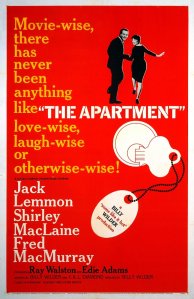
If you’ve been paying attention at all to the “Alternative Picks” of this list, you may have noticed a certain Billy Wider pop-up all over the place. And there is good reason for that, as Mr. Wilder is by far the classic-era director who speaks best to our contemporary day and age and this is because at his heart, the man was a cynical optimist. No one was better at ripping off the shiny veneer of society’s institutions and norms of behaviour to expose the ugly core beneath. But no one was also better of digging deeper to find beauty and joy within, as rough and hidden as they may be.
And nowhere does Wilder’s cynical optimism shine clearer than in The Apartment. At one level, the movie is a systematic dismantling of the myth of the virtues of being a “company man” and is a scything critique of corporate America. But on another level, this movie is simply about two broken individuals caught in the middle of a faceless corporation who are desperate for connection and love. You have Jack Lemmon as Bud Baxter, the faceless worker drone who loans out his uptown apartment to his executive bosses for their risque infidelities in the hopes of corporate advancement but at great personal cost. And then you have Shirley MacLaine, the elevator operator whose heart Lemmon is set on but whose heart has been hurt almost ruinously by yet another lecherous executive. And in the slow journey that brings the two together, not only does Wilder unmask the myth of satisfaction through corporate advancement but he also manages to reveal something deeper and stronger worth living for.
Of course in describing the movie this way I may have undersold just how sweet, warm and tender this film is at its heart. And really how could it not be, with Jack Lemmon being every bit as charming and funny as he always is and Shirley MacLaine perfectly striking the balance between sweetly innocent and tragically jaded? Every New Year’s Eve I plop this in as the perfect counter-programming to the bubbly and baseless positivity of the season. Nothing to me is a bigger remedy to Ryan Seacrest’s perkiness than the call to “Shut up and deal.”
And with that we finally arrive at the top:
1. THE RED SHOES (1948) by Michael Powell and Emeric Pressburger
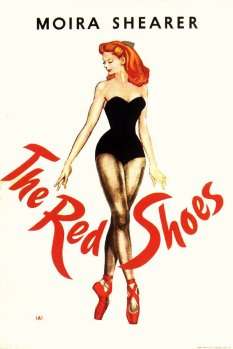
I remember vividly the first time I watched this movie. I was flying home to Malaysia from the States and though the lights in the cabin were turned off to suggest to us that we might try to sleep, my internal clock was suggesting otherwise. And so in a fit of boredom I saw that this movie was on the inflight entertainment system and fired it up. And I was hooked. Now usually watching movies on a tiny dinky screen on the back of a seat while wearing a pair of dinky headphones with the constant drone of the aircraft in the background would classify to me as “less-than-ideal” watching conditions. But it simply speaks more to the hypnotizing power of this movie that even on an airplane I got sucked into the experience.
The movie stars Moira Shearer as a ballerina who rises from rookie to star performer in a prestige ballet company in rapid time and is about the exultant if ephemeral thrill of pursuing artistic perfection and the terrible cost of that pursuit. Of course as with any movie on this (or any best list) to reduce the movie to its plot is to complete miss the point altogether. For though this is theoretically a tragedy, it a tragedy with such energy and vitality as to make you forget of its terrifying message. As with most Powell and Pressburger productions, it is so easy to get swept up in the spectacle surrounding you and in this case that is exactly what you should allow yourself to do.
Nowhere is this most clear than in the centerpiece of this movie which is the ballet’s opening performance of “The Red Shoes” from whence the movie gets it title. Lesser films might be quick to move from opening performance to montage shots of applause, but with The Red Shoes we are treated to as close to a full performance as possible. It is a wild cacophony of colour and sound, punctuated by breathless dancing and riotous sets, all working together to lull you into hypnotic silence as you watch the spectacle. The performance is so great that when the audience breaks out into a standing ovation, you can’t help but want to join in too.
At every level, The Red Shoes is simply a showcase of performers, designers, production crews, and directors mastering their art. Given the fact that I probably am going to gust a lot more about this film in many more posts I will simply leave it at that. But I sincerely doubt you will find a better showcase of what classic cinema has to offer than with this pick right here.
***************
Of course the beauty of classic cinema is that it is almost laughable to try in any way, shape, and form to narrow its essence and power down to ten films. I haven’t found any space on this list for Westerns, epics, sci-fi, or war movies. Most egregiously nothing from the Hollywood New Wave of the 60s made it here, neither did any movie by Sidney Lumet, David Lean, John Cassavetes, or John Ford. Barbara Stanwyck, Jimmy Stewart, Katherine Hepburn, and Humphrey Bogart are just a minuscule sampling of movie stars missing from this list. Needless to say there are big gaping holes in this list. But this list is a start. And hopefully it simply becomes a stepping stone to bigger and greater adventures into classic cinema, as they were for me.
Next Week: Best Art House Films (For People Who Think Art House Films Are For Snobs)
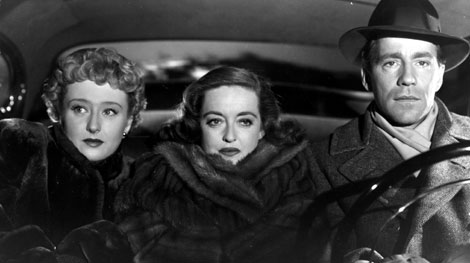


Pingback: Best Art House Films (For Those Who Think Art House Is For Snobs) – Homebody Movies
Pingback: Hall of Fame #2: The Apartment – Homebody Movies
Pingback: Hall of Fame #4: All About Eve – Homebody Movies
I’m going to be honest, seeing as reading this list instantly convinced me to add you to my favourites, I’m kinda stunned this doesn’t have more comments.
LikeLiked by 1 person